




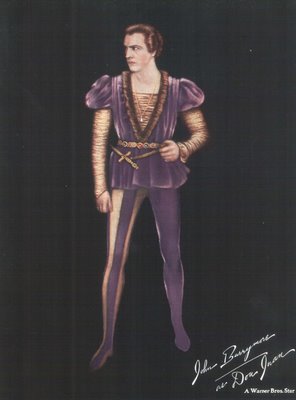
Don Juan and Vitaphone's 80th Anniversary
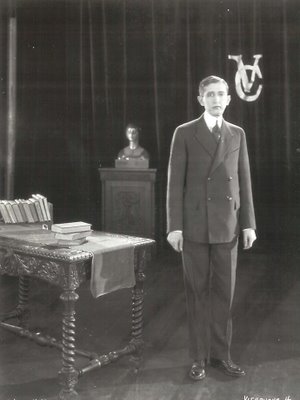
Don Juan opened at the Warner’s Theatre on August 6, 1926. It was the first feature with a synchronized music and effects score on disc. Those are the historical facts. They’ve been recited in countless documentaries during the eighty years that have brought us to this anniversary week. We can only imagine the thrill felt by that premiere audience. There are reviews and anecdotal evidence to suggest what it must have been like --- but are there any live witnesses left? You can watch Don Juan and all its accompanying Vitaphone shorts in beautifully restored versions today, but you’ll never experience emotions those people felt when this revolutionary thing swept down upon them. What in our lifetime can approach it? Color TV maybe. The introduction of compact discs. Our first glimpse of home computers and the Internet, perhaps. But those were mostly private moments, or encounters shared with but a handful of friends or family members. Whatever the impact, it wouldn't have been anything like sitting with 1,360 people in an auditorium quivering with anticipation as Will Hays (shown here) stepped upon a virtual stage and spoke Vitaphonic words to stunned listeners. This was the first time most of them had heard sound recordings reproduced electronically. The effect was --- well, electrifying. Never was there such clarity, range, or volume emanating from a mere shadow on a screen. It was truly a supernatural experience. Warners had bragged about the creative coalition between Bell Telephone, A,T&T, and Western Electric that made such miracles possible. These corporate behemoths were seemingly capable of anything.
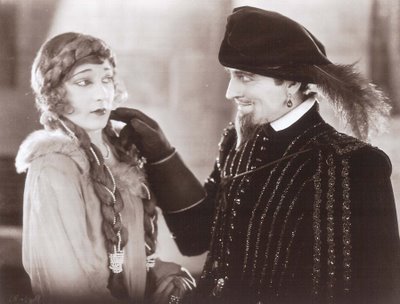
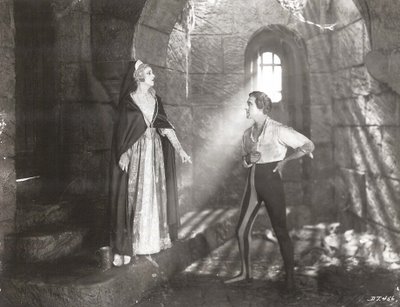
The idea was to bring recorded music into every theatre. Those benighted venues in "far-flung hamlets" were the first concern of cultural ambassadors determined to give all of us the best in recorded sound. We could finally rid ourselves of upright pianos, washboards, slide whistles --- whatever primitive instruments urban dwellers assumed were being played to accompany silent movies in the sticks. Telephones had united the country. Now Warner Bros. would finish the job with Vitaphone. Dialogue was not a consideration at first. Don Juan had been shot silent in late 1925, and was intended for release that way, but was held back for a score to be grafted onto disc during the summer of 1926. Opera, vaudeville, and concert luminaries were also recorded during June and July (in the defunct Manhattan Opera House, hastily converted into a soundstage). A looming August 6 opening called for twenty-four hour work schedules among technicians assigned to install sound equipment in a theatre designed as a silent house. Speakers were planted in the orchestra pit, and by some accounts, off to the sides of the screen as well. Vitaphone was a process wherein a disc, separate from the film, played (hopefully) in synchronization with the image being projected. It seemed a magician would be required to pull off a thing like this, but Warners had the place filled with magicians, each of them dedicated to getting through that opening show sans any breakdown. With a largely invited audience of New York opinion makers filling their seats, Warners knew this night would either make or break Vitaphone.

Mechanical screw-ups had defeated would-be sound pioneers before. There were repeated efforts during the early twenties that went down in flames, but none of them had the muscle Warners flexed on August 6. The nearest thing to a resurrection, said one ecstatic observer. The Vitaphone shorts were the big noise that night. New York elites were flattered by the highbrow stuff aimed squarely at them. The Philharmonic played Richard Wagner’s Tannhauser, and the audience applauded as the conductor took his bow at the conclusion. It seemed as though he were right there in the auditorium! Giovanni Martinelli performed a selection from I Pagliacci and the crowd rose to their feet for a sustained ovation. Martinelli was sitting in the audience that night, but viewers didn’t know it. They were cheering a projected image. When have any of us ever done that? It’s true they’d soon tire of it. Subsequent Vitaphone shorts with performers taking on-screen bows would be met with stony silence, or laughter. Novelties then as now wear out quickly. Other snafus were minor. Opera soprano Marion Talley was hitting high notes the equipment couldn’t register, and some of her portion was out of sync. Picture and sound crashed a few times toward the end of Don Juan, but that was attributed to a nervous operator (nervous? I bet the guy checked into Bellevue the next day --- talk about pressure!). Margins for error were reduced by the near continual presence of recording engineer Stanley Watkins, who stationed himself in the audience with a telephone hook-up to the projection booth and a bank of push buttons to sound the alert upstairs if something went wrong during the show. As Don Juan enjoyed a nine-month run at the Warner’s, Watkins estimated he’d seen the whole program over ninety times.
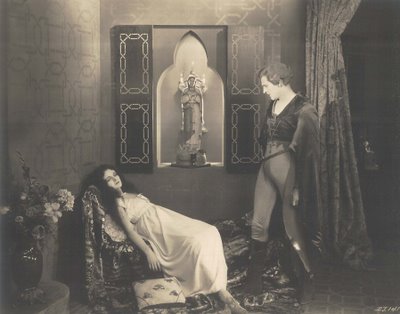

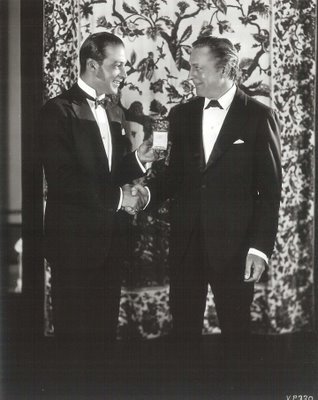
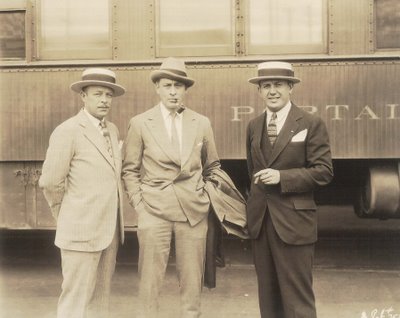 The thing we lost with the introduction of Vitaphone was the comforting reality of a live orchestra. The personal, or human touch, is absent, they said. You had to get used to that metallic quality in the sound. It lacked the snap, or edge, of real acoustics. Most critics were agreed on this point. Mechanical sound was no substitute for the real thing, and in those urban centers, they’d been plenty spoiled by splendid accompanists down in the pit. All this reminded me of the debate over long-playing albums vs. CD’s. Record proponents will still tell you that discs lack warmth and body --- the music sounds too mechanical. Given enough years, of course, those of us who remember LP’s will have died out and gone, just as those defenders of live music were eventually supplanted by their Vitaphone successors. Everything’s replaced by something else eventually, but is the replacement necessarily better? No matter. Those theatre orchestras were headed for the scrap heap and no argument about their superior quality was going to save them. We’ll be hearing this debate again when digital projection finally replaces 35mm film, as it's pretty much a certainty that 35mm’s a goner. Once the media empires have made up their minds to scuttle it, we may kiss that format goodbye.
The thing we lost with the introduction of Vitaphone was the comforting reality of a live orchestra. The personal, or human touch, is absent, they said. You had to get used to that metallic quality in the sound. It lacked the snap, or edge, of real acoustics. Most critics were agreed on this point. Mechanical sound was no substitute for the real thing, and in those urban centers, they’d been plenty spoiled by splendid accompanists down in the pit. All this reminded me of the debate over long-playing albums vs. CD’s. Record proponents will still tell you that discs lack warmth and body --- the music sounds too mechanical. Given enough years, of course, those of us who remember LP’s will have died out and gone, just as those defenders of live music were eventually supplanted by their Vitaphone successors. Everything’s replaced by something else eventually, but is the replacement necessarily better? No matter. Those theatre orchestras were headed for the scrap heap and no argument about their superior quality was going to save them. We’ll be hearing this debate again when digital projection finally replaces 35mm film, as it's pretty much a certainty that 35mm’s a goner. Once the media empires have made up their minds to scuttle it, we may kiss that format goodbye.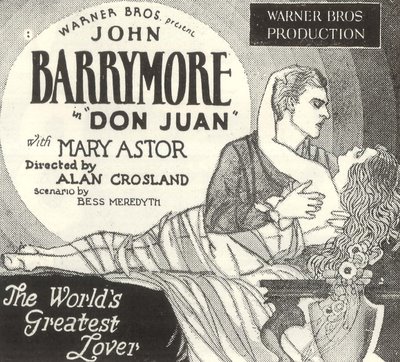
The complete Don Juan/Vitaphone program was released on laser disc back in the nineties. If you can locate one of these on ebay, you’ll see pretty much what played at the Warners Theatre on August 6, 1926. Getting through the shorts may prove a greater challenge today than for first-nighters, however. I surrendered to the refuge of my fast-forward button after the first few, but I did want to get the flavor of what it might have been like to experience these performances for the first time. Don Juan was something else. I’d seen it years ago, knew it was good, and was delighted to find it surpassed even my happy recollection of it. John Barrymore as the title character was in his forties at the time and looked it, especially in comparison with younger screen idols such as Rudolph Valentino, shown here with Barrymore at an awards presentation. The powdered wigs and sprayed on tights don't necessarily become him, but Jack's game for the dual role he plays (more convincing as father than son) and does it all with good humor. Barrymore’s prestige had a lot to do with Vitaphone’s initial success, as his very name implied the heady lights of Broadway, plus long runs and advanced admissions attendant thereto. He was worth the $76,000 per picture fee he got from Warners (here director Harry Beaumont and Jack Warner meet him at the train station). Don Juan would end up playing most of its engagements silent, as few theatres were wired at the time, but it was a solid hit --- against a negative cost of $546,000, it brought back $1.2 million in domestic rentals, with $435,000 foreign. Final profit was a stellar $473,000, a number that anticipated fantastic returns Warners would enjoy with forthcoming Vitaphone releases. Those successes of the next three or so years would put this company in the top bracket among producers and forever identify Warners as the pioneers of sound.
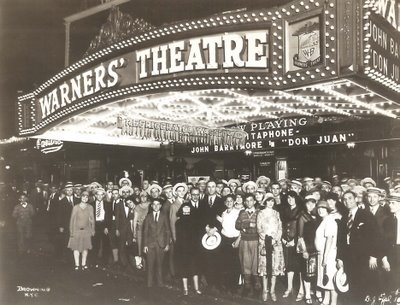
5 Comments:
The Museum of Modern Art (in New York) ran the original Vitaphone program on the premiere's 60th anniversary and, let me tell you, the audience -- a full house -- ate it up. It was as if we were at the Warners Theatre in 1926. But probably the best part was that the wife of Roy Smeck, the guitar player in one of the shorts, was in the audience as well. I can only wonder what kind of a time-travel trip it was for her.
Wow --- Thanks for passing that along, East Side. I'd heard about that anniversary show, and sure wish I could have been there.
"They were cheering a projected image. When have any of us ever done that?"
Just once: at an opening day screening of Disney's Beauty and the Beast in Hollywood. At the conclusion of the "Be Our Guest" number, everyone broke into cheers and applause. It felt as if we were attending a Broadway musical and had just witnessed a show-stopping number... which, of course, we had, but this was a projected pen-and-ink rendition.
So, in a sense, I've had a small taste of what it must have been like back in '26.
As far as applause goes, many's the time that I was in an LA audience in the 80s that gave good hands to musical numbers.
I especially remember a Fred Astaire series at the Art Museum that got consistently good hands after numbers, and it was gratifying to see that, 50 years later, the timing was still right. The action would more or less pause and pick up again just as the applause was over.
Michael and Dave,
I think what John means is that it's amazing to think of an audience applauding the very phenomenon of sound.
But as Dave says, if anyone can still get a theatre audience to burst into applause, it's Fred Astaire. I've seen it many times!
Post a Comment
<< Home